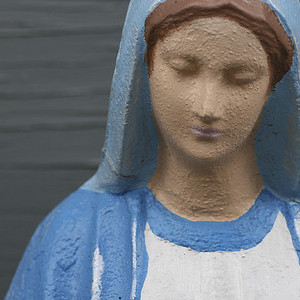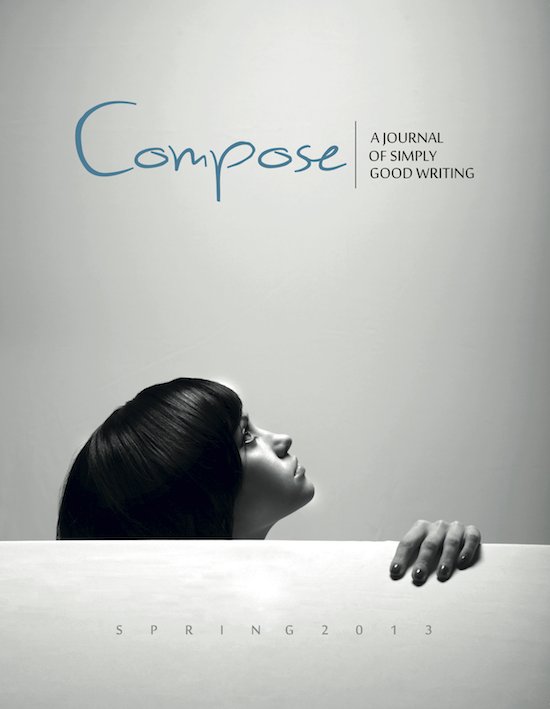Our Lady of the Carpeted Stairs

An excerpt from Queen of the Fall: A Memoir of Girls and Goddesses (University of Nebraska Press, 2015).
I’m not the one who placed the Virgin outside the priest’s office.
But when he stood by my side and said I’m onto you with a wink, I went along with it. I’d long ago acquired the habit of hiding how little I knew and more than that, I feared losing that speck of connection, the small but meaningful space between the Father’s wink and his words: I’m onto you.
I had no father of my own, just the story of a man who’d traveled the New York State Thruway selling vacuum cleaners, stopping between Albany and Buffalo for a bite to eat, a soft reception. We’d only been an off-ramp to him, my mother and I, which may explain why I’d been trying to connect with the one called Father since I was a child. And because I had no arsenal of obvious charms at my disposal, I used what I knew to lure him, whipping up storms in the gulf of my mouth and sending them his way, twisted ribbons of longing.
I was twenty when the wink arose between us but remembered when, years before, he was new to the parish, a fresh-scrubbed priest walking our neighborhood, shining his light on streets others refused to enter. He most loved a girl whose last name was a stew of delicious syllables—LaMarata—a name that sounded to me like a prayer. She was sick and the Father kept a picture that LaMarata had colored hanging beside his rectory desk. He must have looked at it every day, taking in the crayoned lines on his way in and out of the office, staring into the mash of flowers, making a point of remembering the dying child, the brevity of life, the way nothing is guaranteed. And how low I was that I envied the girl the purity of her illness, when all those years before, a good priest appeared suddenly among us, back when I was nothing so much as a little hurricane, before the wink and the words I’m onto you.
When the wink came, I was living in the rectory and there were times—certain mornings, or the hour between Sunday Masses— when the door to his office flung wide and the priest tumbled forth as if propelled by a gust of wind, spilling toward the piano in the living room. I’d hear the start of the keys and slip down the stairs, sitting on a step just out of sight and listening to what came from his playing, something hard and loose and far from the precision of the piano student from Missouri. For all this talk, it might seem as if I loved the priest the way some girls take to older men, the way some parishioners fall for ministers. But no, he was simply a man whose goodness intrigued me. First, that such goodness could exist, and second, that it was directed so firmly at the world apart from me.
Is my delight so hard to imagine then—the warmth of the wink, the familiarity of the words? I’m onto you. The only real surprise was the speed with which I offered up my gummy smile, the ease with which I neither confirmed nor denied, and in my silence pretended I had indeed placed the statue of the Blessed Mother outside his office door. And when, the next morning, the Virgin appeared on the landing of the stairs near my room, I stood open-mouthed like Bernadette in her cave at Massabielle or Lúcia dos Santos dropping the bundle of sticks she’d collected when the Lady showed herself at Fátima. I became faithful pilgrim and startled peasant girl as I stood there, the sight of Our Lady of the Carpeted Stairs nearly causing me to fall backward. Then I remembered—I’m onto you—and though I had not started this game, I laughed and laid claim, hauling the waist-high statue into my room. She became a shared joke then, the Virgin, going back and forth between us: under a kitchen table, in the little-used office on the third floor, behind the drapery in the large meeting room. More smiles and winks, Our Lady becoming a sort of holy baton, an invisible string connecting the two of us—winks and more winks—until the night I placed her on the lid of the closed toilet in the priest’s private bathroom.
I’d walked into his office a few times before, enjoying the view through his window, the small patch of grass, the line of books, staring at the coloring made by the sick child all those years before. I wandered in again the night I placed the Virgin on the toilet lid, taking a seat and staring at the same water stain in the ceiling that had been there since I was a girl. All the times I’d been in that office as a child: dragged in by my mother for the humiliation of family counseling, for my firing as an altar girl ten years prior, stopping by to say hello before Thursday night folk Masses, shifting my feet while making up questions in an attempt to hold him. The same office I’d occupy a few years later, sitting beside the man I’d marry, his voice ratcheting with each word spoken, nervousness translating into volume because he was modest and a Lutheran and what had he ever done to deserve interrogation about heaven, the saints, and accepting children with open arms should they come?
But that was future and past, and as I sat in the priest’s office on that night, hands resting on the head of the Virgin, I only stared out the window trying to decide the next move in a game I’d lacked the boldness to invent.
How did it come to me then, the bathroom?
It wasn’t that I didn’t revere Our Lady. I’d always admired Mary, not praying to her so much as finding comfort in her presence. As a child, I’d listened to the stories of our religion—the water and the wine, Mary and Gabriel, Lazarus’s return from the dead—and seen them as a dream blossoming just under the surface of the everyday world, a beautiful dream, one shared and dipped into during Mass. But one day something tipped me off, a thing said at church, someone hinting at the reality of Mary made pregnant without sex, so that I had no choice but to quiz anyone who’d answer, asking about the matter over and over: Do you really believe? I persisted beyond politeness, thinking people too shy to speak, thinking they’d lumped Mary in with Santa Claus, magical stories they safeguarded for children. I asked until their faces turned, eyebrows rising, foreheads gathering into lines—until I finally understood. Others believed differently. Literally. I was perhaps alone in the dream. I continued coming to Mass but backed off from saying things I didn’t believe. But not from Mary, never from Mary—the lone figure of a woman among men, the one soft spot you could count on in any church—and because a woman becoming pregnant without a husband was what I knew best, I required no magic to adore her.
Even as I lifted the statue and placed the Virgin in the bathroom, I never thought to offend. I wanted only to succeed in this game and required a place that had not yet been tried, and there it was. A tiled grotto complete with raised platform. And when, the next morning, the priest did not smile or wink, when he did not even look in my direction and the air between us became as thick as it ever had been, and Our Lady failing to appear to me again, I knew I’d taken things too far—which, in reality, was less disappointment than confirmation, for I have always had a way of taking things too far.
I’m onto you.
I suppose that more than anything I feared that the priest had always been onto me in some meaningful way—as if with his goodness he was able to spot its opposite in the blustery child and ten years later, in the wide-eyed woman living in his former rooms. I was nothing like the girl with the illness, the one whose name would always be the sound of a prayer. I was nothing like the statue of Our Lady, sweet and pink and waiting to be moved—I asked too many questions, was a tad too fast with the wisecrack, and there was a hunger about me that fell in strange shapes from my eyes. How much more difficult, adoration, in the living breathing world.
Twenty years have come and gone, and still how little I know. Except that he was wrong about the Virgin. I was not the one who lifted her by the slender waist and set her blue and blooming before his door.
I was simply the one who stared into the faded colors of another girl’s picture, trying to unravel the mechanics of adoration from the way she crayoned her lines. The one crouched on the staircase on certain Sundays, listening to the mess of music rise from the piano, the sound as choppy and glorious as a springtime storm. The one whose heart pounded as the sound came, caught up in something I could not name as he played. The one who sat watching the Father as he rose from the bench, headed back to his office, letting the door close all the way behind him.

Excerpted from Queen of the Fall: A Memoir of Girls and Goddesses by Sonja Livingston by permission of the University of Nebraska Press. © 2015 by the Board of Regents of the University of Nebraska. Available at nebraskapress.unl.edu or wherever books are sold.










